The color purple is a unique color in the natural world. When humans see purple, it is often associated with royalty and luxury. In animals, this color is rare. To get purple birds, the structure of colorless cells in feathers must be arranged in a way that reflects light at the right wavelength.
In birds, sexual dimorphism is typical, where males are brightly colored and females are not. For many bird species, the more brilliant the colors of the feathers, the more attractive the males are to the females.
In this article, we will explore the unique characteristics and life histories of purple birds found all over the world.
Here is the list of species of purple birds:
- Purple Martin
- Violet-backed Starling
- Purple Honeycreeper
- Purple Grenadier
- Costa’s Hummingbird
- Purple-backed Thornbill
- Grey-headed Swamphen
- Purple-throated Mountain-gem
- Common Grackle
- Violet Sabrewing
10 Amazing Species of Purple Birds:
1. Purple Martin
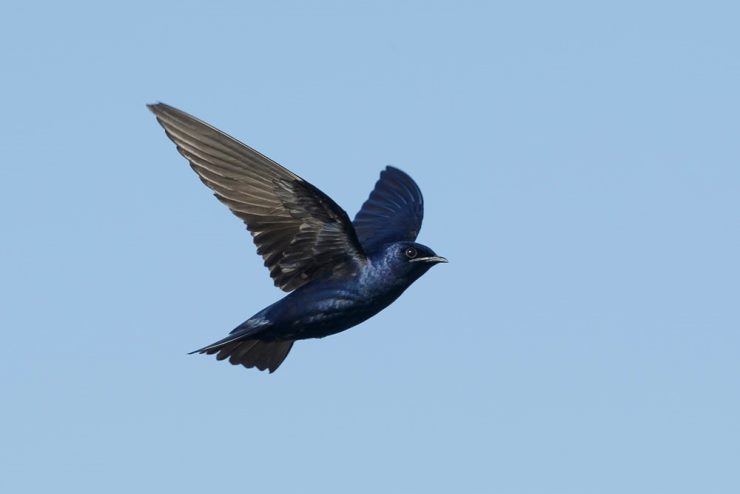
- Scientific name: Progne subis
- Size: 7.5 to 8.5 inches in length (19 to 21.5 centimeters)
- Weight: 1.6 to 2.1 ounces (45 to 60 grams)
- Wingspan: 15.3 to 16.1 inches (39 to 41 centimeters)
The average size of Purple Martins is 7.9 inches (20 cm), making this species the largest in the swallow family, Hirundinidae. Purple martins are like many other bird species where the male is brightly colored and the female is not.
Male purple martins have distinctive, deep-purple feathers. They are often found nesting in colonies in wide open spaces near ponds and lakes. Their primary food source, flying insects, is easily foraged from the air by these voracious predators.
Purple Martins migrate south from North America to South America each winter. When they return to North America in the spring, they often prefer nesting close to people’s houses.
These noisy birds have distinct vocalizations at different times of the day. One call in particular sounds like a mixture of bubbles and clicking.
To attract these birds, homeowners living near water can install nest boxes made from various materials such as gourds or aluminum. These boxes can be purchased online, in stores, or constructed. The nest boxes should be attached to a pole more than 12 feet high (3.6 meters).
Fun Fact: The adage that purple martins eat 2,000 mosquitos a day is not true. Mosquitos actually make up only a small percentage of their diet.
2. Violet-backed Starling
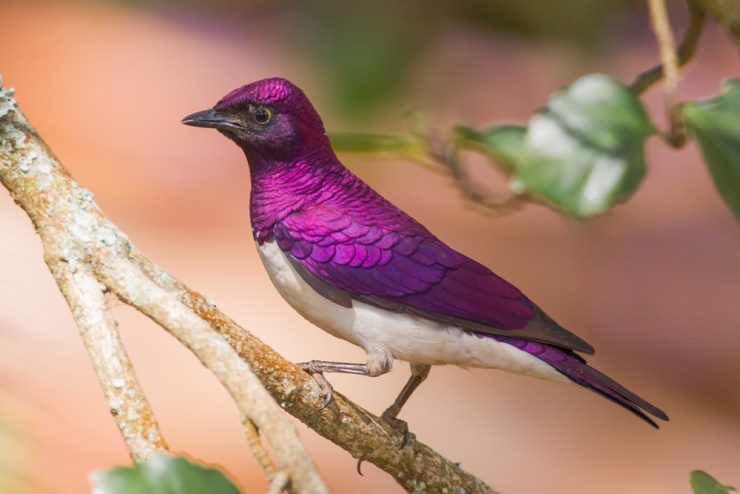
- Scientific name: Cinnyricinclus leucogaster
- Size: 6.5 to 7 inches in length (17 to 18 centimeters)
- Weight: 1.3 to 2 ounces (39 to 56 grams), averaging 1.5 ounces (45 grams)
- Wingspan: unknown
The Violet-backed Starling is one of the smallest starlings in the family Sturnidae and the only one in its genus. Other common names for this species includes plum-colored starling and amethyst starling.
Male violet-backed starlings have an iridescent violet hue with ultraviolet reflectance on their back, making them look good to females. The females have white feathers on their abdomen, but their back feathers are a brown color, similar to that of a thrush.
This species is commonly found throughout Sub-Saharan Africa in forests and wooded areas. They typically eat fruits, seeds, and berries, but will also eat arthropods like termites and ants. Mistletoe is widely dispersed as a result of violet-backed starlings eating the berries and dispersing the seeds in their droppings.
Violet-backed starlings do migrate in the winter, moving north towards the Sahara when temperatures drop in the south. These birds are monogamous and often travel together in small flocks outside of breeding season.
During the breeding season, monogamous pairs nest together to raise their young. Nests are usually built in cavities of trees, holes in the shoreline of a river, or holes in fence posts.
Fun Fact: During termite swarms, violet-backed starlings can often be found voraciously gorging on these insects.
3. Purple Honeycreeper

- Scientific name: Cyanerpes caeruleus
- Size: 4 to 4.5 inches in length (10.5 to 11 centimeters)
- Weight: 0.4 ounces (12 grams)
- Wingspan: unknown
Purple Honeycreeper is a small bird in the tanager family, Thraupidae, the second-largest bird family. This bird is commonly found throughout its range in northern South America.
The male purple honeycreeper has bright purple-blue feathers all over its body, black wing feathers, and yellow legs. It has a long, curved, black bill. Females have bright green feathers on their bodies and reddish plumage on their heads, allowing them to blend in with their surroundings.
This species is typically found throughout the Amazon rainforest in Peru, Colombia, Brazil, Venezuela, Bolivia, and Ecuador. These birds can also be found on cocoa and citrus plantations. As rainforest birds, purple honeycreepers do not migrate.
Purple honeycreepers eat a variety of things including insects, fruits, berries, seeds, and nectar. These birds are opportunistic and eat what they can forage from the forest canopy.
These birds hang out in small flocks, often with birds of other species. The female builds a small nest in trees and incubates and raises her young alone. During the breeding season, males can be aggressive.
Fun Fact: Purple honeycreepers wings beat really fast when they hover, and they hang upside down from fruit as they eat the seeds.
4. Purple Grenadier
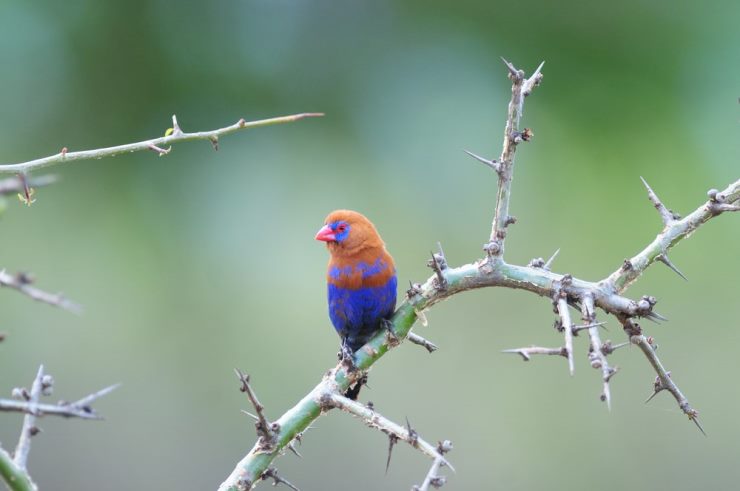
- Scientific name: Granatina ianthinogaster
- Size: 5.25 to 5.5 inches in length (13 to 14 centimeters)
- Weight: 0.4 ounces (12 grams)
- Wingspan: unknown
The Purple Grenadier is a common bird in the finch family, Estrildidae. This species is found throughout eastern Africa in the tropical and subtropical shrubland in that region. They are listed as a species of Least Concern in the countries of Uganda, Sudan, Somalia, Kenya, Ethiopia, and Tanzania.
Male and female purple grenadiers are sexually dimorphic. Males have purple-blue feathers around their eyes and across their chest and abdomen. Their heads have russet-colored feathers, light brown feathers on their backs, and black tail feathers.
Female purple grenadiers have light blue feathers around their eyes and brown feathers on the rest of their bodies. White feathers are scattered throughout the brown feathers creating a spotted or striped pattern.
Purple grenadiers eat a variety of foods from grass seeds to insects. The insects they eat include termites, spiders, and aphids.
In nature, purple grenadiers go through an extensive, showy courtship display and then build a nest in a low shrub or bush where males and females raise their young together. These birds do not usually flock together and may be aggressive towards birds that are a closely-related species.
Fun Fact: This species is popular with bird lovers. They make great pets and are often kept in cages by bird hobbyists all over the world.
5. Costa’s Hummingbird
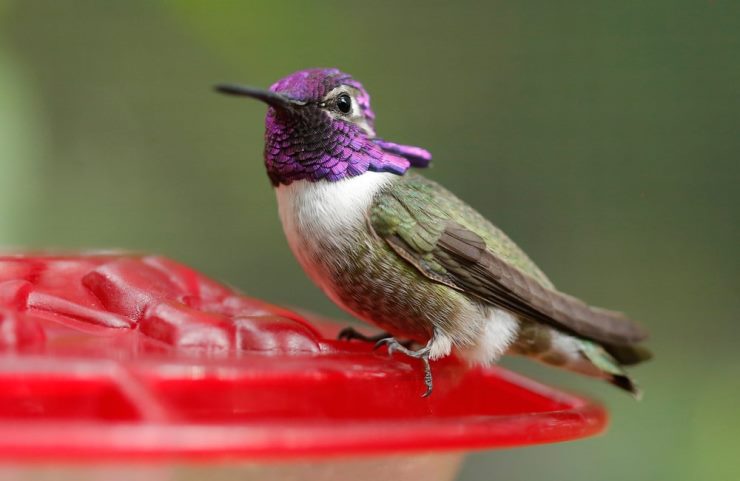
- Scientific name: Calypte costae
- Size: 3 to 3.5 inches in length (7.6 to 8.9 centimeters)
- Weight: 0.1 ounce (3 to 3.2 grams)
- Wingspan: 4.3 inches (11 centimeters)
The Costa’s Hummingbird is a tiny bird in the hummingbird family, Trochilidae. The vibrant violet feathers that adorn the males of this species are used to flash females to impress them during the breeding season.
Females, in comparison, are drabber in color, with their gray-green feathers. During the breeding season, females build their tiny nests in tall cacti or small trees.
This species is found throughout the southwestern United States in southern California, southern Nevada, Arizona, and even New Mexico. Their range extends into the Baja California Peninsula and the West Coast of Mexico.
The Costa’s hummingbirds that live in the interior southwestern United States in the dry, open landscape of the Sonoran Desert. In the summers when the desert is hottest, they migrate south to coastal regions in the Mexican states of Baja California, Sinaloa, and Nayarit.
Like all hummingbirds, Costa’s hummingbirds eat nectar from desert plants like agave, desert honeysuckle, and chuparosa. In addition, they sometimes feed on tiny insects.
Fun Fact: As humans have increasingly populated the southwestern part of the United States, Costa’s hummingbird, as well as similar species, have increased their range. People often put out hummingbird feeders, providing sufficient food for increasing numbers of hummingbirds.
6. Purple-backed Thornbill
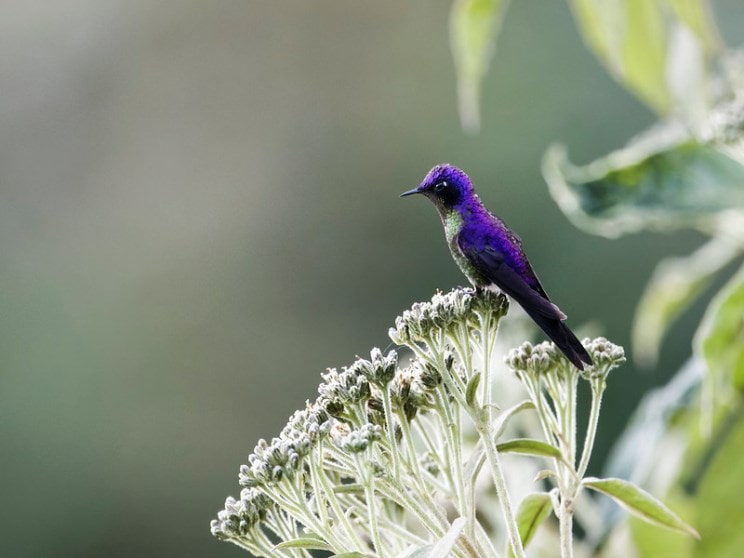
Photo by Nick Athanas on Flickr- Scientific name: Ramphomicron microrhynchum
- Size: 3.1 to 3.5 inches in length (7.9 to 8.9 centimeters)
- Weight: 0.1 ounce (3.5 grams)
- Wingspan: unknown
The Purple-backed Thornbill has the smallest bill of any hummingbird in the family Trochilidae. The males of this species have bright purple feathers on their back, a white spot behind the eye, iridescent green feathers on their throat, and a deeply-forked tail with dark purple and black feathers.
Female purple-backed thornbills have green feathers on their back and a white spot behind their eye, similar to males. The tail feathers of females are not as deeply forked as those of the males.
The female purple-backed thornbills build their nests with moss and lichen in the trees located throughout the forests of their range. Not much is known yet about their breeding practices.
The range of purple-backed thornbills extends along the Andes mountain forests through the South American countries of Bolivia, Colombia, Ecuador, Venezuela, and Peru. These birds do not migrate out of the tropical and subtropical montane forests where they live.
Purple-backed thornbills eat nectar like other species of hummingbird. In addition, they often capture small insects that they find on the flower petals where they feed.
Not-So-Fun Fact: Purple-backed thornbills are vulnerable to deforestation in their range. While scientists do not know the extent of their population’s numbers, they believe the species is in decline.
7. Grey-headed Swamphen
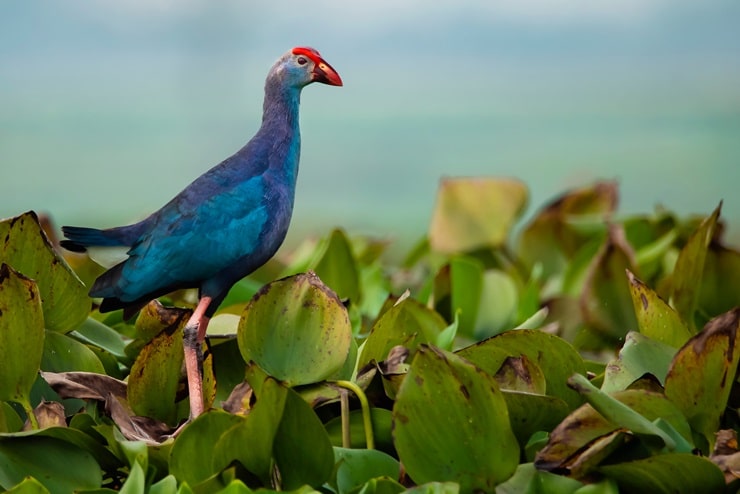
- Scientific name: Porphyrio poliocephalus
- Size: 15 to 19.7 inches in length (38 to 50 centimeters)
- Weight: 30 to 37 ounces (850 to 1,050 grams)
- Wingspan: 35.4 to 39.4 inches (89.9 to 100 centimeters)
The Grey-headed Swamphen is a small waterfowl in the family Rallidae. This species is native throughout southern Europe, the Middle East, the Indian subcontinent, southern China, and northern Thailand.
Male and female grey-headed swamphens do not express sexual dimorphism. Both genders have purple and turquoise feathers all over their body, white feathers underneath, a red spot between their eyes, and a red beak.
The courtship behavior involves a male dancing for a female with pieces of aquatic vegetation. Both males and females take turns sitting on the nest and taking care of the young after hatching.
This species lives in marshes and swamps and along vegetated shorelines of rivers and lakes. The diet of grey-headed swamphens consists of aquatic vegetation and small animals such as snails, fish, lizards, and frogs.
Fun Fact: As a result of the pet bird trade, grey-headed swamphens were brought to the United States. In the early 1990s, some of these birds escaped captivity into the wild and have become naturalized invaders in Florida. Their US range now extends throughout Florida into Georgia and South Carolina.
8. Purple-throated Mountain-gem
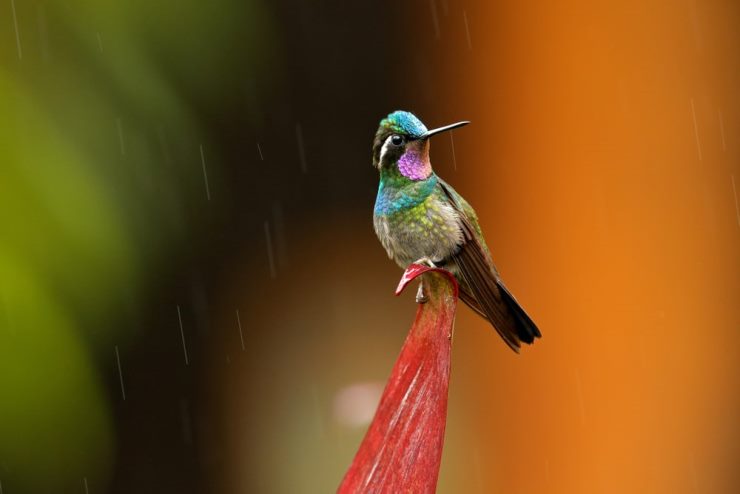
- Scientific name: Lampornis calolaemus
- Size: 3.9 to 4.5 inches in length (10 to 11.5 centimeters)
- Weight: 0.16 to 0.21 ounces (4.5 to 6 grams)
- Wingspan: unknown
The Purple-throated Mountain-gem is a medium-sized, Latin-American hummingbird in the family Trochilidae. This species is found throughout the mountains of Costa Rica, Panama, and Nicaragua.
Male purple-throated mountain-gems have bright purple feathers on their throat, green feathers on the body, blue-green feathers on the head, and a white line behind the eye. Females are similarly-colored to the males but with lighter-colored chest and abdominal feathers.
Like all hummingbirds, purple-throated mountain-gems primarily eat nectar, favoring red flowers which generally have the most sugar. During the breeding season, this species also eats small insects that they find on the flower petals.
This species breeds during the winter in the rainy season. Females build small nests in bamboo or trees located in the forest understory. Females incubate their eggs and tend the fledglings for approximately six weeks.
Fun Fact: People that live in these countries can coax the purple-throated mountain-gem down from the high-elevation forests in which they live by placing hummingbird feeders around their homes.
9. Common Grackle
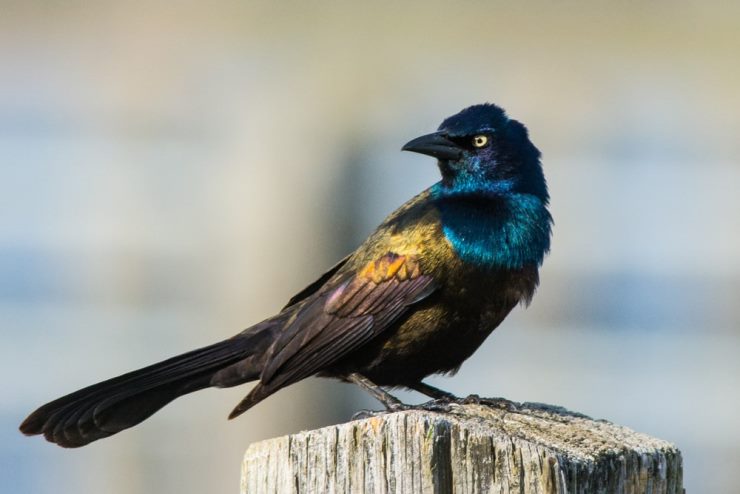
- Scientific name: Quiscalus quiscula
- Size: 11 to 13.3 inches in length (28 to 34 centimeters)
- Weight: 2.6 to 5 ounces (74 to 142 grams)
- Wingspan: 14 to 18 inches (36 to 46 centimeters)
The Common Grackle is a New World blackbird in the Icteridae family. This species is found throughout North America, and the population has expanded into unforested and even urban areas across its range.
Grackles that reside in the northern parts of North America migrate in flocks further south during the winter months. Resident birds in the southern part of their range usually do not migrate.
The males of this species have iridescent feathers that reflect purple, blue, and green colors. Female grackles have less iridescent wings and typically appear solid black. Common grackles often flock together, sometimes in very large groups called a plague.
These birds are often seen at bird feeders and eat a wide variety of items. They are often viewed as a pest in agricultural fields because one part of their diet includes grain, especially corn. In addition to grain, their diet consists of insects, acorns, seeds, nuts, berries, and frogs.
This species builds nests in birdhouses or other man-made cavities, often in colonies. Both males and females build the nests and care for the young. Males tend to be unaggressive toward other males and cooperative during the breeding season.
Fun Fact: The common grackle can detect the Earth’s magnetic field. However, it is unknown how this species uses that magnetic field.
10. Violet Sabrewing

- Scientific name: Campylopterus hemileucurus
- Size: 5.9 inches in length (15 centimeters)
- Weight: 0.3 to 0.4 ounces (9 to 12 grams)
- Wingspan: 3.25 inches (8.2 centimeters)
The Violet Sabrewing is the largest hummingbird outside of South America in the family Trochilidae. This bird’s range extends throughout Latin America into southeastern Mexico.
The male violet sabrewing has a brilliant purple plumage that looks almost black until the sunlight catches the feathers. Females are dark green and gray with a patch of violet feathers at their throats. Both genders have long, curved, black beaks.
Violet sabrewings occur in tropical coastal regions, forests, and grasslands at high elevations. They do not migrate because the climate in their range remains consistent and their food sources are available year-round.
This species, like other hummingbirds, eats nectar from a variety of flowers. They also eat small insects such as spiders, ants, and small beetles.
Females build their small nests in trees and after fertilization is complete, males leave and females incubate and raise the young.
Fun Fact: The violet sabrewing is an important pollinator species for the trees used on shade-grown coffee plantations. Without this species and others like them, coffee production would be reduced.
Other Colored Birds:
Pink Birds
Red Birds
Orange Birds
